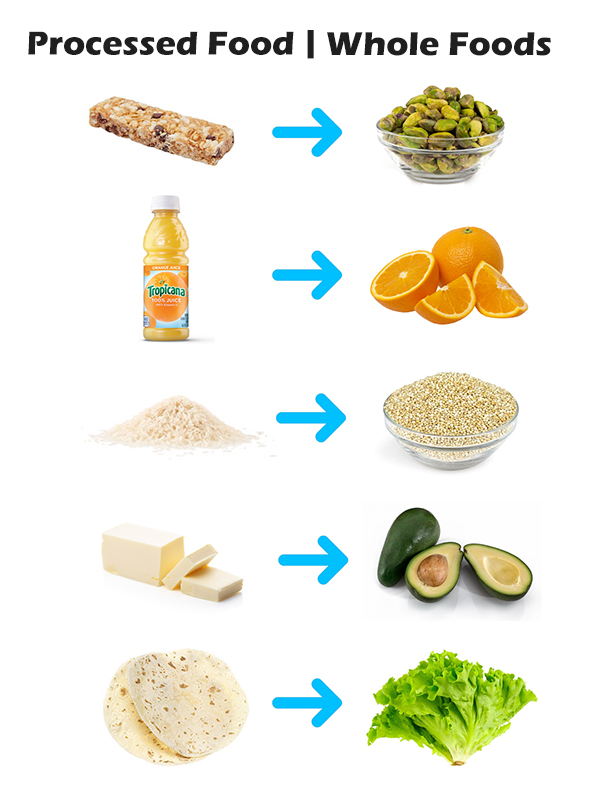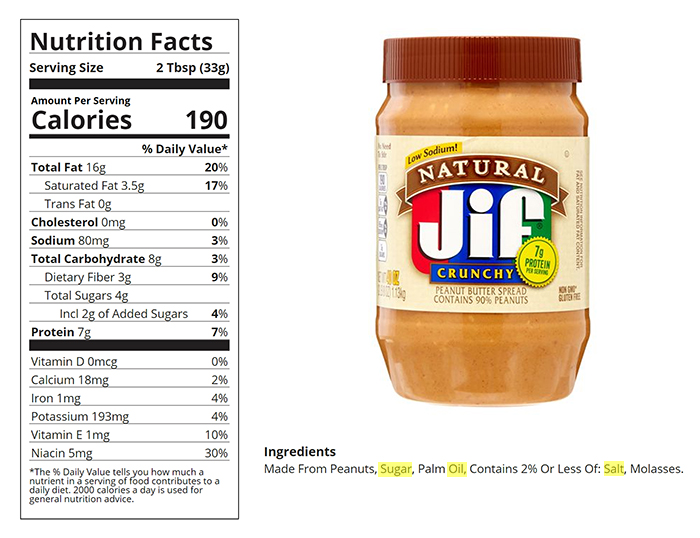There was a time when my diet consisted of only processed foods. All of which had added salt, oil and sugar to a degree that was both addictive and dangerous in the long term. When I learned about whole foods and the benefit they provided, it caused me to reexamine my diet. In 10th grade, that meant reviewing what was in my lunch box. What my lunch box boiled down to was a peanut butter sandwich, barbecue chips, gushers, sugar frosted cookies and a Kool-Aid pouch. This lunch was the exact opposite of a whole foods lunch. It was heavily processed, salted, oiled and sugared. And, I was eating that everyday. You can see how eventually, that would have caused a problem if I didn’t change my diet… obesity, high blood pressure, high cholesterol, diabetes, cancer, dementia, stroke… ok it would have caused more than a few problems. Now, over a decade later, I’ll reexamine how learning of whole foods has changed my eating habits.
What is a Whole Foods Diet?
Whole foods are foods in their original, unprocessed form. They’re foods without added sugars, oils, salts, preservatives, sweeteners or artificial colors. They’re foods that are mostly raw and grown. They’re foods that should make up 95% of our diet but aren’t being consumed nearly enough. In fact, a recent study concluded that over 60% of the calories consumed in America are “highly” processed, leaving whole foods at around 20% with the remaining 20% being somewhere in-between.
What’s the problem with this? Well, by processing food, we’re taking whole foods and stripping away a lot of the healthy components like fiber. This is done to make the food taste better and last longer. Then, additional processing can be performed to add sugar, oil and salt to increase the taste and longevity even more. On top of that, highly processed foods will add artificial colors to make the food look even more appetizing. In the end, we’re left with frankensteined food that has been stripped of the healthy components and injected with the unhealthy, addictive components. This is a recipe for problems and malnutrition.
What Are The Benefits?
The benefits of whole foods starts with ending our addiction with processed foods. Without knowing it, the standard american has some form of addiction with processed foods. Is addiction possible with food? It turns out that when predisposed, rats will choose to indulge in pure sugar over cocaine. They’ll even run across electrical grids to consume M&Ms. In humans, food addictions have a lot of the same traits as alcohol addictions, and brain scans show receptors respond to processed foods in the same way they’d respond to other known drugs. Food addiction is real and its a problem that causes people to over-consume calories and under-consume nutrients. By consuming a diet of whole foods, you’re able step away from that food addiction and experience food the way is was meant to be eaten. In whole, in its entirety, with all of its nutrients and benefits.
By consuming a whole foods diet, you can not only end food addictions, but you can:
- Dramatically reduce risk of heart disease (the leading killer in the US)
- Eliminate nearly all cases of Type 2 diabetes
- Naturally bring your weight to a healthy level and make it nearly impossible to gain excessive weight
- Significantly decrease your chance of cancer
- Increase sustained energy levels throughout the day
- Reduce cognitive decline and risk of cognitive disease
- Truly understand hunger instead of “hanger”
Not only are there tons of studies showing the benefits of whole foods, there aren’t many if any studies contradicting this perspective. No matter what kind of diet you believe in, shifting away from processed foods and towards whole foods is almost universally agreed upon to be extremely healthy.
Example Food Swaps
How can you start consuming a whole foods diet? I think the easiest way is to look at the foods you are consuming and swap them for healthy, whole foods. In the case of my 10th grade lunch, I could start with my peanut butter sandwich. First, the peanut butter I consumed was the extremely popular JIF. Now, most people think peanut butter is healthy but if you take a look at the ingredient label of JIF, you’ll see the added sugars, oils and salts that make it so addictive and unhealthy. Now, if you wanted to swap the JIF peanut butter for something healthier, you might look towards JIF natural peanut butter. It turns out, that this style has removed some of the additives found in the original JIF, but still retains the sugars, oils and salts that make it addictive and unhealthy. To be healthy, we want a minimally processed food without added sugars, oils and salts. To do that, I had to look even harder to find what I now consume, Once Again Organic Peanut Butter. It has one ingredient: Peanuts. Below, I’ve captured pictures of these three peanut butters to show you the ingredient list. This is where you can identify what’s actually included in a food. As you can see, JIF clearly doesn’t fit into a whole foods diet.
Next, let’s perform a whole foods swap on the bread I was using for the sandwich. I was using a generic white bread that was highly processed, stripped of fiber, and filled with additives. This could easily be swapped for a 100% whole grain bread like Ezekiel Sprouted Whole Grain Bread. Feel free to read the bread’s ingredient list here and you’ll see its made from whole foods.
Now that my sandwich has been made healthier, let’s quickly address the rest of my 10th grade lunchbox. Chips could be swapped for carrots and hummus. Gushers could be swapped for strawberries and blueberries. Sugar cookies could be swapped for a black bean brownie. And, my Kool-Aid could easily be swapped with water. These simple swaps of processed foods for whole foods are quick changes that can be made for a host of healthy benefits.
If you’re still having trouble understanding what whole foods are versus processed foods, I’ve included a chart with a few more examples.

Another trick to distinguish a whole food is by seeing if there’s a brand name plastered on it. By looking above, you probably know the brand name of your favorite granola bar, orange juice, white rice, butter and tortillas. But, you probably don’t know the brand name of your pistachios, oranges, quinoa, avocado and lettuce. This is because brands don’t often process and market whole foods. Farms grow and sell them.
A Day Eating Whole Foods
Now that we’ve defined and understand whole foods, what can a day of eating whole foods look like? Let me give you a glimpse:
- 10AM Breakfast: Oatmeal topped with berries, nuts and seeds.
- 1PM Lunch: Leafy green salad with peppers, onions, carrots, grapes and a nut-based dressing
- 4PM Snacks: Handful of cashews and an apple
- 7PM Dinner: Rice bowl with black beans, grilled vegetables and guacamole
This glimpse above is not only cheap and easy to make, but healthier than what almost every american is eating today.
Final Thoughts
Consuming whole foods instead of processed foods is one of the simplest and most beneficial things you can do for your nutrition. Processed foods can become highly addictive with their added sugars, oils and salts. This addiction can cause an over-consumption of calories and under-consumption of nutrients. This will inevitably end with malnutrition and numerous diseases. Luckily, all of that can be avoided by consuming a diet filled with whole foods. I challenge you to review your daily meals and look for ways to swap processed foods for whole foods. These small swaps will cause huge improvements when performed consistently over a long period of time. Let’s get swapping.
If you liked this post, please subscribe to the weekly newsletter and follow the social media accounts for the latest content!

Hey, I am Brandon Zerbe
Welcome to myHealthSciences! My goal has always been to increase quality-of-life with healthy habits that are sustainable, efficient and effective. I do this by covering topics like Fitness, Nutrition, Sleep, Cognitive Health, Financial Independence and Minimalism. You can read more about me here.
Sources:
- The United States has an Epidemic of Processed Food — and it’s Killing Us
- 7 Reasons to Choose a Plant-Based Diet
- The Health Benefits of Eating a Plant-Based Diet and How to Get Started
- Food Addiction vs. Sugar Addiction: What’s the Difference?
- More Than Half of What Americans Eat Is ‘Ultra-Processed’
- Why and How to Choose Plant-Based Whole Foods Over Processed Foods
- Whole-Foods, Plant-Based Diet: A Detailed Beginner’s Guide
Disclosure: I frequently review or recommend products and services that I own and use. If you buy these products or services using the links on this site, I receive a small referral commission. This doesn’t impact my review or recommendation.



